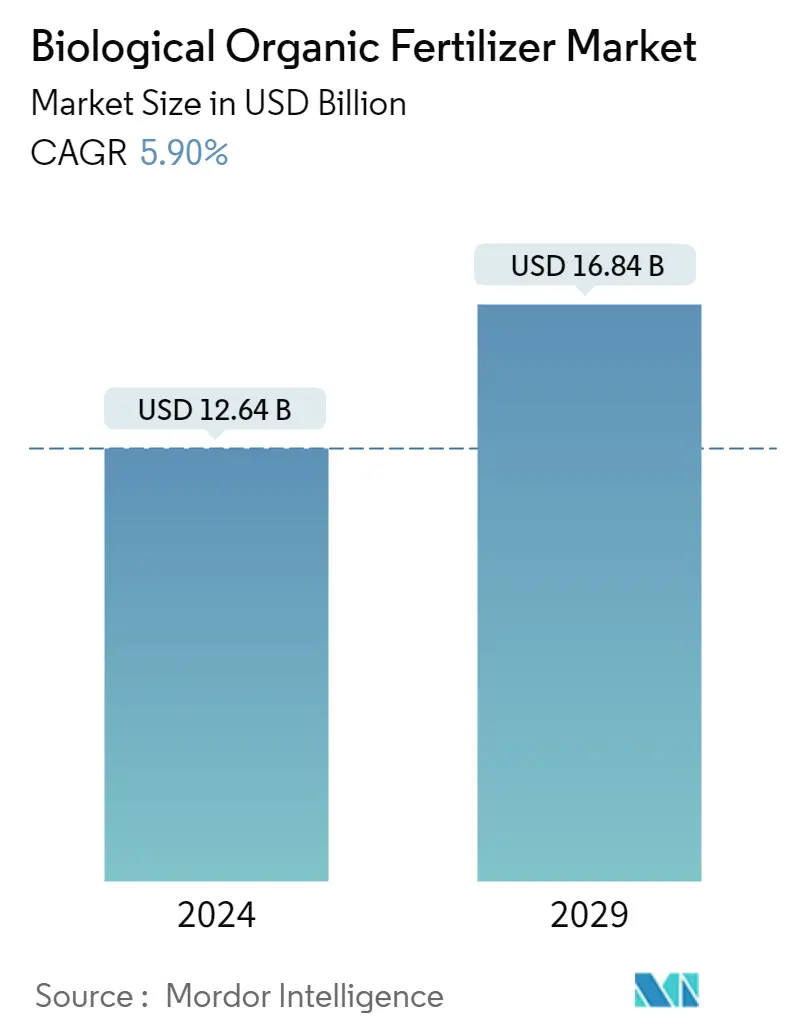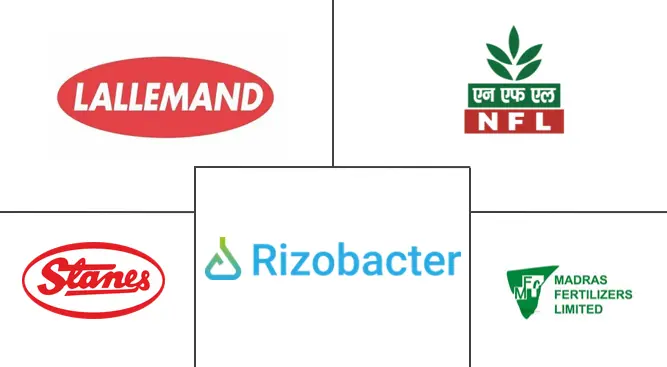Market Size of Biological Organic Fertilizer Industry

| Study Period | 2019 - 2029 |
| Market Size (2024) | USD 12.64 Billion |
| Market Size (2029) | USD 16.84 Billion |
| CAGR (2024 - 2029) | 5.90 % |
| Fastest Growing Market | Asia Pacific |
| Largest Market | North America |
Major Players
*Disclaimer: Major Players sorted in no particular order |
Biological Organic Fertilizer Market Analysis
The Biological Organic Fertilizer Market size is estimated at USD 12.64 billion in 2024, and is expected to reach USD 16.84 billion by 2029, growing at a CAGR of 5.90% during the forecast period (2024-2029).
- The increased practice of organic farming is one of the significant factors behind the growth of the biological organic fertilizer market. The emphasis on sustainable agriculture and government support to the manufacturers are the other factors that augment the development of the market.
- Moreover, recent studies have shown the effect of bio-organic fertilizers on grains. Bio-organic fertilizer that exhibited various qualities, such as nutrient acquisition and plant growth promotion of rice, is an organic-based biofertilizer that contains RP (5%), biochar (15%), and the living cells of Plant Growth Promoting Bacteria (PGPB), mostly Bacillus, Proteus, and Paenibacillus spp., which were isolated from the floodplain, terrace, and saline soils. The results of 16 field experiments and 18 farmers' demonstration trials undertaken by Bangladesh Rice proved that added PGPB supplemented the 30% synthetic N requirement of rice production through biological nitrogen fixation and fully complemented available P from rock phosphate by solubilization during the plant growth period. The combined effect of living ingredients and organic matter of the bio-organic fertilizer saved 30% urea-N, eliminated 100% Triple Super Phosphate fertilizer use in rice production, and simultaneously improved nutrient uptake, N, P use efficiencies, rice yield, and soil health, eventually enhancing the adoption of biological organic fertilizers.
Biological Organic Fertilizer Industry Segmentation
Biological Organic Fertilizers refer to a type of fertilizer that combines microbial and organic fertilizer benefits. These fertilizers are primarily made from animal and plant residues combined with inert organic and decaying materials. In other words, Biological Organic Fertilizer is a processed inoculated compost from any organic material that has undergone rapid decomposition by introducing homogeneous microbial inoculants. The biological organic fertilizers market is segmented by Type (Microorganism and Organic residues), Application (Grains and Cereals, Pulses and Oilseeds, Fruits and Vegetables, Commercial Crops, and Turf and Ornamentals), and Geography into (North America, Europe, Asia-Pacific, South America, and Africa). The report offers market size and forecasts in terms of value in USD million.
| Type | |||||||||
| |||||||||
|
| Application | |
| Grains and Cereals | |
| Pulses and Oilseeds | |
| Fruits and Vegetables | |
| Commercial Crops | |
| Turf and Ornamentals |
| Geography | |||||||||
| |||||||||
| |||||||||
| |||||||||
| |||||||||
|
Biological Organic Fertilizer Market Size Summary
The biological organic fertilizer market is experiencing significant growth, driven by the increasing adoption of organic farming practices and a strong emphasis on sustainable agriculture. Government support and the rising demand for organic products have further fueled this expansion. The market is characterized by the use of natural organic fertilizers, which are rich in microorganisms and derived from animal and plant sources, making them ideal for organic farming. The Asia-Pacific region is leading this growth, with countries like China and India at the forefront, due to their large agricultural bases and increasing awareness of the benefits of bio-based fertilizers. Regulatory frameworks in these countries aim to ensure the quality of organic fertilizers, contributing to market development.
The market is fragmented, with numerous international and regional players actively participating. Companies are focusing on collaborations, market expansion, and product innovation to strengthen their positions. Notable players include Rizobacter Argentina S.A, Lallemand Inc., and National Fertilizers Limited. Recent strategic moves, such as acquisitions and partnerships, highlight the industry's commitment to enhancing biological portfolios and expanding into new regions. The unregulated nature of the market has allowed small companies to thrive, but there is potential for consolidation with the introduction of more stringent regulations. Overall, the biological organic fertilizer market is poised for continued growth, supported by the global shift towards organic and regenerative agriculture.
Biological Organic Fertilizer Market Size - Table of Contents
-
1. MARKET DYNAMICS
-
1.1 Market Overview
-
1.2 Market Drivers
-
1.3 Market Restraints
-
1.4 Porter's Five Force Analysis
-
1.4.1 Bargaining Power of Suppliers
-
1.4.2 Bargaining Power of Buyers/Consumers
-
1.4.3 Threat of New Entrants
-
1.4.4 Threat of Substitute Products
-
1.4.5 Intensity of Competitive Rivalry
-
-
-
2. MARKET SEGMENTATION
-
2.1 Type
-
2.1.1 Microorganism
-
2.1.1.1 Rhizobium
-
2.1.1.2 Azotobacter
-
2.1.1.3 Azospirillum
-
2.1.1.4 Blue-green Algae
-
2.1.1.5 Phosphate Solubilizing Bacteria
-
2.1.1.6 Mycorrhiza
-
2.1.1.7 Other Microorganisms
-
-
2.1.2 Organic residues
-
2.1.2.1 Green Manure
-
2.1.2.2 Fish Meal
-
2.1.2.3 Bone Meal
-
2.1.2.4 Oil Cakes
-
2.1.2.5 Others
-
-
-
2.2 Application
-
2.2.1 Grains and Cereals
-
2.2.2 Pulses and Oilseeds
-
2.2.3 Fruits and Vegetables
-
2.2.4 Commercial Crops
-
2.2.5 Turf and Ornamentals
-
-
2.3 Geography
-
2.3.1 North America
-
2.3.1.1 United States
-
2.3.1.2 Canada
-
2.3.1.3 Mexico
-
2.3.1.4 Rest of North America
-
-
2.3.2 Europe
-
2.3.2.1 Germany
-
2.3.2.2 United Kingdom
-
2.3.2.3 France
-
2.3.2.4 Spain
-
2.3.2.5 Italy
-
2.3.2.6 Russia
-
2.3.2.7 Rest of Europe
-
-
2.3.3 Asia Pacific
-
2.3.3.1 China
-
2.3.3.2 Japan
-
2.3.3.3 India
-
2.3.3.4 Australia
-
2.3.3.5 Rest of Asia-Pacific
-
-
2.3.4 South America
-
2.3.4.1 Brazil
-
2.3.4.2 Argentina
-
2.3.4.3 Rest of South America
-
-
2.3.5 Africa
-
2.3.5.1 South Africa
-
2.3.5.2 Rest of Africa
-
-
-
Biological Organic Fertilizer Market Size FAQs
How big is the Biological Organic Fertilizer Market?
The Biological Organic Fertilizer Market size is expected to reach USD 12.64 billion in 2024 and grow at a CAGR of 5.90% to reach USD 16.84 billion by 2029.
What is the current Biological Organic Fertilizer Market size?
In 2024, the Biological Organic Fertilizer Market size is expected to reach USD 12.64 billion.

